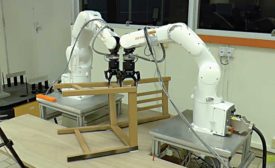Automated Assembly Systems
Data analysis allows for predictive maintenance and quality control
Read More
Feeders for Medical Device Assembly
From vibratory bowls to shaker tables, medical device engineers have many options for feeding parts to automated assembly systems.
May 1, 2018
Automated Assembly of Medical Devices
Sharps, test cards, sensors and miniature gas canisters are among the many medical devices produced on automated assembly systems
May 1, 2018
Robotic System Assembles Cords
A unique multistation automated assembly system produces six different cord sets.
April 13, 2018
Industry 4.0 Drives Conveyor Technology
New products feature flexibility and energy efficiency
April 4, 2018
Flexible Fixtures for Automated Assembly
Researchers have developed a hexapod-based reconfigurable fixture that can be used to assemble a family of automotive headlights.
March 5, 2018
Rotary Actuators for Automated Assembly
Decades-long refinement makes today’s rotary actuators more precise and versatile than ever
February 6, 2018
Never miss the latest news and trends driving the manufacturing industry
Stay in the know on the latest assembly trends.
JOIN TODAY!Copyright ©2024. All Rights Reserved BNP Media.
Design, CMS, Hosting & Web Development :: ePublishing












